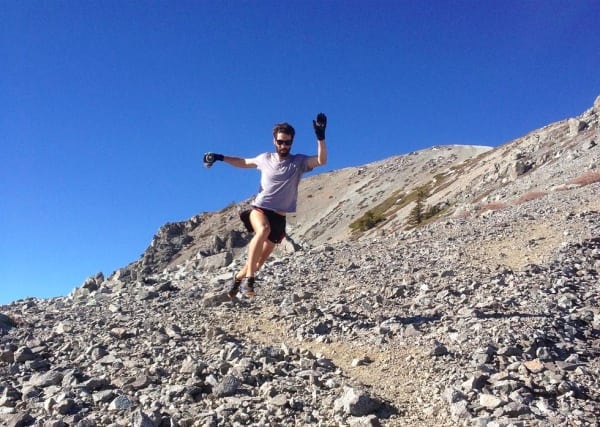Over the past couple years, one word that runners have frequently dropped when talking about their favorite shoes is: drop. The differential between the height of the heel and the forefoot (drop) has become a more important factor in how runners decide what shoes work for them. In general, forefoot runners look for shoes with 0-6mm of drop to allow for good forefoot articulation and freedom of movement, while heel strikers are generally comfortable in 10mm+ drop shoes. However, there are some exceptions to this, as a wider offering of shoes with varying structures and geometries have been released to bridge this gap and fit more niches in the market. We’ll discuss a little history, the pros and cons of each side of the aisle, and some examples of exceptions to the trend.
Historically, running shoe drops have gradually grown. In the 1960s, many shoes were around 4-8mm in classics such as the ASICS Pinto and New Balance Trackster. They then rose to 8-12mm through the advance of airbags and gel cushioning in the 90s, and eventually an all-time high of 15+mm in the Nike Shox Turbo. This trend persisted because of market demand for more and more heel cushion. Born to Run spurred a shift in the opposite direction as more runners began buying minimal drop racing flats, causing running shoe companies to respond and produce niche models, such as the New Balance Minimus line and Brooks Pure Project.
To better illustrate what this all means, go out and try on a pair of high heels (Guys, if anyone asks, just say you’re studying advanced biomechanics.). Never mind the color or how good they make your calves look, but instead focus on how your arch and ankle feel. Do you notice that they are effectively immobilized and your stability is a small fraction of what it normally is? This is an example of how too much drop in a running shoe puts your foot at too steep an angle, compromising its natural ability to stabilize itself. Demanding technical terrain found in races like the Hardrock 100 or the HURT 100 favor stable, low drop shoes that keep the foot’s center of gravity low and positions it at a stable angle.

The author illustrating low-drop control in the New Balance MT110’s on the technical mountain trails of Mt. Baldy, CA.
Now, get on a treadmill with no shoes on, and crank up the speed to your normal 10k race pace. How long can you hold it? Unless you’re an avid barefoot runner, chances are there’s much more stress in your arch and calf to provide natural/active cushioning for your stride. Active cushioning by the foot can wear on a runner in flatter, more consistent terrain, like what is often found in a road marathon or groomed fire roads. In races like the Badwater Ultramarathon or the Umstead 100 Mile, the consistent terrain often requires shoes that give more cushion and support for the repetitive, straight-away miles.

Katie DeSplinter utilizing the 11mm drop of the New Balance RC1400 on rolling singletrack near Michigan Bluff, CA.
Running shoe companies build varying degrees of drop into shoes to achieve unique design goals for each model. The following trends usually occur with traditional designs and technologies:
- Higher drop shoes (10mm+) lower the levels of active cushioning required by the body and quicken the toe-off. In other words, the impact of your stride requires less tension in you foot/arch/ankles/calves/knees/quads, and immediately rolls your foot forward to toe off. The trade-off: these shoes can be heavier, less stable in technical terrain, and make active cushioning muscles weak and injury prone (i.e. IT Band Syndrome, plantar fasciitis, and patellar tendonitis).
- Lower drop shoes (0-8mm) allow more arch and ankle articulation for better trail feel and are generally lighter, with less material. However, they also require increased active cushioning (muscles and tendons you use running barefoot to cushion your stride), and require a runner to power through their turnover with their own feet.
Though these trends are generally true, there are a few glaring exceptions:
Cushioned minimal drop
The Hoka One One Mafate (4mm drop) – These maximalist cushioning shoes are very dynamic, as each foot strike compresses the extra soft foam as far as the runner’s stride wants to go and requires no active cushioning from the runner.
Variance in minimal drop
The New Balance MT10 “Minimus Trail” vs. the Saucony Peregrine (both 4mm) – the Minimus is much closer to the broader minimal shoe trend as it requires more active cushioning with its thin sole and flexible last, as well as a hollow arch that allows for freedom of movement in the arch and ankle. Meanwhile, the Saucony Peregrine has identical drop, but a thicker and stiffer sole accompanied with a filled in arch that makes it more supportive, cushioned and restrictive. These two shoes feature identical “minimal drop,” but each platform uses the drop in different ways. The Peregrine uses it to save weight and improve control, while the Minimus uses it to allow the foot greater freedom of motion and encourage active cushioning from the runner.
High drop variance in weight and support
The New Balance RC1400 vs. the ASICS GT-2160 (both 11mm) – The RC1400 has two hollowed out notches in the arch and heel that allow for a more natural flex and less weight. The GT-2160 has gel pads through the heel and a stiff plastic truss in the midfoot, along with a dual density foam insert under the arch to prevent any excess arch or ankle movement. The RC1400 uses the 11mm drop to replicate the feel of a more cushioned, heavier trainer while still allowing some natural foot articulation in a 7 ounce package. The GT-2160 uses the 11mm drop to mount a strong arch support and cushioning system that prevents over-pronation and efficiently transfers hard heel impacts into smooth toe offs.
Zero drop variance in cushion and protection
The Vibram Five Fingers KSO vs. the Altra Lone Peak (both 0mm drop) – The KSO offers a basic rubber outsole to protect the foot from general road debris, while allowing complete natural movement of the foot and encouraging active cushioning from the runner. The Lone Peak takes protection two steps further with a rock plate as well as significant cushioning in both the forefoot and heel. As a result, the KSO uses zero drop to deliver an honest barefoot experience while the Lone Peak utilizes it to encourage forefoot striking with ample protection.
So what is the perfect drop? At the end of the day, that’s up to you. Your terrain, biomechanical needs, and personal preferences determine your ideal combination of drop, cushioning, and support. The “minimalist movement” isn’t defined by the lightest, lowest drop shoe you can find; rather its all about finding the least amount of shoe you need to enjoy running efficiently and injury free. Nothing more. Nothing less.
Call for Comments (from Bryon)
- If you look for “minimalist” shoes (whatever that means to you), what factors are most important to you: heel-to-toe drop, total stack height, fore- and midfoot flexibility, weight, a certain combination of these, or something else entirely?
- If you pay attention to such things, which heel-to-toe drop do you most enjoy running in?
- Do you vary the drop of your shoe depending on the manner in which you’ll be using it?
- Any folks use traditional drop (10-12mm) shoes most of the time, but mix in lower drop shoes from time-to-time?
